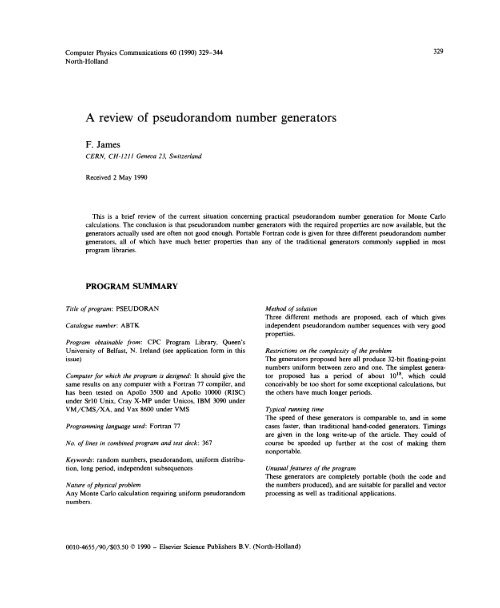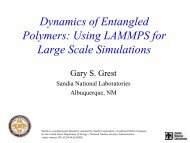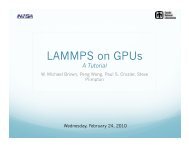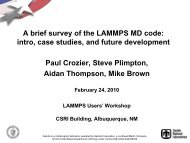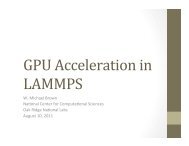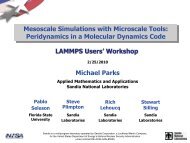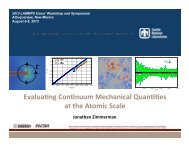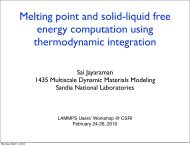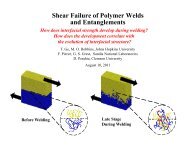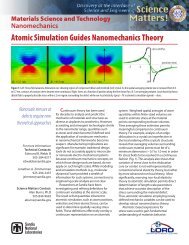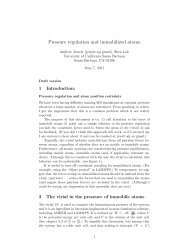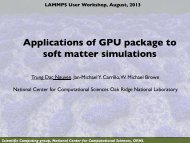A review of pseudorandom number generators - Lammps
A review of pseudorandom number generators - Lammps
A review of pseudorandom number generators - Lammps
You also want an ePaper? Increase the reach of your titles
YUMPU automatically turns print PDFs into web optimized ePapers that Google loves.
Computer Physics Communications 60 (1990) 329—344 329<br />
North-Holland<br />
A <strong>review</strong> <strong>of</strong> <strong>pseudorandom</strong> <strong>number</strong> <strong>generators</strong><br />
F. James<br />
CERN, CH-1211 Geneva 23, Switzerland<br />
Received 2 May 1990<br />
This is a brief <strong>review</strong> <strong>of</strong> the current situation concerning practical <strong>pseudorandom</strong> <strong>number</strong> generation for Monte Carlo<br />
calculations. The conclusion is that <strong>pseudorandom</strong> <strong>number</strong> <strong>generators</strong> with the required properties are now available, but the<br />
<strong>generators</strong> actually used are <strong>of</strong>ten not good enough. Portable Fortran code is given for three different <strong>pseudorandom</strong> <strong>number</strong><br />
<strong>generators</strong>, all <strong>of</strong> which have much better properties than any <strong>of</strong> the traditional <strong>generators</strong> commonly supplied in most<br />
program libraries.<br />
PROGRAM SUMMARY<br />
Title <strong>of</strong>program: PSEUDORAN<br />
Catalogue <strong>number</strong>: ABTK<br />
Program obtainable from: CPC Program Library, Queen’s<br />
University <strong>of</strong> Belfast, N. Ireland (see application form in this<br />
issue)<br />
Method <strong>of</strong> solution<br />
Three different methods are proposed, each <strong>of</strong> which gives<br />
independent <strong>pseudorandom</strong> <strong>number</strong> sequences with very good<br />
properties.<br />
Restrictions on the complexity <strong>of</strong> the problem<br />
The <strong>generators</strong> proposed here all produce 32-bit floating-point<br />
<strong>number</strong>s uniform between zero and one. The simplest genera-<br />
Computer for which the program is designed: It should give the tor proposed has a period <strong>of</strong> about 1018, which could<br />
same results on any computer with a Fortran 77 compiler, and conceivably be too short for some exceptional calculations, but<br />
has been tested on Apollo 3500 and Apollo 10000 (RISC) the others have much longer periods.<br />
under SrlO Unix, Cray X-MP under Unicos, IBM 3090 under<br />
VM/CMS/XA, and Vax 8600 under VMS<br />
Typical running time<br />
The speed <strong>of</strong> these <strong>generators</strong> is comparable to, and in some<br />
Programming language used: Fortran 77<br />
No. <strong>of</strong> lines in combined program and test deck: 367<br />
Keywords: random <strong>number</strong>s, <strong>pseudorandom</strong>, uniform distribution,<br />
long period, independent subsequences<br />
Nature <strong>of</strong> physical problem<br />
Any Monte Carlo calculation requiring uniform <strong>pseudorandom</strong><br />
<strong>number</strong>s.<br />
cases faster, than traditional hand-coded <strong>generators</strong>. Timings<br />
are given in the long write-up <strong>of</strong> the article. They could <strong>of</strong><br />
course be speeded up further at the cost <strong>of</strong> making them<br />
nonportable.<br />
Unusualfeatures <strong>of</strong> the program<br />
These <strong>generators</strong> are completely portable (both the code and<br />
the <strong>number</strong>s produced), and are suitable for parallel and vector<br />
processing as well as traditional applications.<br />
0010-4655/90/$03.50 © 1990 — Elsevier Science Publishers B.V. (North-Holland)
330 F. James / A <strong>review</strong> <strong>of</strong><strong>pseudorandom</strong> <strong>number</strong> <strong>generators</strong><br />
LONG WRITE-UP<br />
1. General considerations<br />
1.1. The motivation and scope <strong>of</strong> this paper<br />
Physicists <strong>of</strong>ten need very good random <strong>number</strong> <strong>generators</strong> for Monte Carlo calculations, but seldom<br />
feel the need to spend any considerable effort to assure themselves <strong>of</strong> the quality <strong>of</strong> the <strong>generators</strong> they<br />
use. Unfortunately, even though the <strong>generators</strong> available at most computer centres were considered good<br />
when they were first installed, it is unlikely that a generator <strong>of</strong> twenty or even ten years ago will continue<br />
to meet the requirements <strong>of</strong> today’s increasingly long and complex calculations. Indeed the history <strong>of</strong><br />
Monte Carlo computation has been marked, from the earliest days right up to the present, by physicists<br />
making the painful discovery that their calculations are unreliable because the local random <strong>number</strong><br />
generator did not have the properties required <strong>of</strong> it. I will spare many readers from unpleasant<br />
recollections by not citing the many internal reports devoted to the revelation that the local “<strong>of</strong>ficial<br />
random <strong>number</strong> generator” is not random enough.<br />
Recent progress in both theoretical understanding and practical implementation <strong>of</strong> random <strong>number</strong><br />
<strong>generators</strong> has been such that it is now possible to find an appropriate generator available <strong>of</strong>f the shelf for<br />
nearly any practical computation. The purpose <strong>of</strong> this <strong>review</strong> is to summarize the requirements for a good<br />
generator, and to give examples <strong>of</strong> <strong>generators</strong> fulfilling these requirements. It is up to the individual<br />
physicists to make sure that the one they use (and preferably the default at their computer centre) is<br />
appropriate for their calculations.<br />
Only uniform <strong>generators</strong> are covered here. There exist in addition an enormous <strong>number</strong> <strong>of</strong> techniques<br />
for generating random <strong>number</strong>s according to other distributions, for example Gaussian, Poisson, binomial,<br />
exponential, etc. Most <strong>of</strong> these techniques require a good uniform generator underneath.<br />
1.2. The three types <strong>of</strong> <strong>generators</strong><br />
Random <strong>number</strong> <strong>generators</strong> for Monte Carlo calculations can be classified according to the three types<br />
<strong>of</strong> <strong>number</strong>s generated:<br />
• Truly random <strong>number</strong>s are unpredictable in advance and must be produced by a random physical<br />
process, such as radioactive decay. Series <strong>of</strong> such <strong>number</strong>s are available on magnetic tape or published<br />
in books, but they are extremely clumsy to use and are generally insufficient in both <strong>number</strong> and<br />
accuracy for serious calculations. They are not discussed here any further.<br />
• Pseudorandom <strong>number</strong>s are produced in the computer by a simple numerical algorithm, and are<br />
therefore not truly random, but any given sequence <strong>of</strong> <strong>pseudorandom</strong> <strong>number</strong>s is supposed to appear<br />
random to someone who doesn’t know the algorithm. These are the most commonly used and are<br />
discussed below.<br />
• Quasirandom <strong>number</strong>s are also produced by a numerical algorithm, but are not designed to appear to<br />
be random, but rather to be distributed as uniformly as possible, in order to reduce the errors in Monte<br />
Carlo integration. They are not appropriate for all Monte Carlo calculations, but can be highly<br />
advantageous where appropriate. These are not discussed in this paper, but will be the subject <strong>of</strong> a<br />
future paper.<br />
1.3. Desirable properties <strong>of</strong> a random <strong>number</strong> generator<br />
The first property given below (good distribution) is important for all calculations. The other properties<br />
are not always needed, but a good general purpose generator should possess them all.
F. James / A <strong>review</strong> <strong>of</strong><strong>pseudorandom</strong> <strong>number</strong> <strong>generators</strong> 331<br />
1. Good distribution. For <strong>pseudorandom</strong> <strong>number</strong>s, this means good randomness. For quasirandom<br />
<strong>number</strong>s, the desired quality is uniformity. The exact meaning <strong>of</strong> these terms in the context <strong>of</strong> this paper is<br />
discussed below.<br />
2. Long period. Both <strong>pseudorandom</strong> and quasirandom <strong>generators</strong> always have a period, after which<br />
they begin to generate the same sequence <strong>of</strong> <strong>number</strong>s over again. In any particular calculation, it is<br />
dangerous to come anywhere near exhausting the period, especially for <strong>pseudorandom</strong> <strong>generators</strong>. In the<br />
early days it was believed that a long period was sufficient also to guarantee a good distribution, but this is<br />
now known not to be true in general. Traditional <strong>pseudorandom</strong> <strong>generators</strong> are based on a single integer<br />
“seed”, which means that the period is limited to the <strong>number</strong> <strong>of</strong> different states that can be represented in<br />
one computer word. For practical reasons, two bits are usually lost (for positivity and to avoid even<br />
integers), so for a 32 bit computer a simple generator can have a maximum period <strong>of</strong> 230 or about i0 9.<br />
Although it is easy to achieve this maximum, it is no longer enough for many present day problems.<br />
Traditional methods can be extended, even on 32-bit computers, to give periods equal to the <strong>number</strong> <strong>of</strong><br />
states representable in 60 bits. Some modern methods have periods much longer than 260; these methods<br />
will be referred to as VLP (very long period) methods.<br />
3. Repeatability. There are really two aspects:<br />
• For testing and development, it may be necessary to repeat a calculation with exactly the same random<br />
<strong>number</strong>s as in the previous run. Nearly all <strong>generators</strong> do this by default, the only exception being those<br />
few that introduce an element <strong>of</strong> true randomness by initializing to an external device like the system<br />
clock.<br />
• A somewhat more tricky case, again arising in program testing, is to be able to repeat part <strong>of</strong> a job<br />
without redoing the whole thing. For example, in event simulation, if event <strong>number</strong> 368 provokes an<br />
exception, one wants to be able to study it again without regenerating the first 367 events. As a general<br />
rule, this requires recording the state <strong>of</strong> the generator at the beginning <strong>of</strong> each event, which for simple<br />
<strong>generators</strong> means only remembering one <strong>number</strong>, the seed. More complex <strong>generators</strong> require storing a<br />
larger amount <strong>of</strong> information; one <strong>of</strong> the <strong>generators</strong> recommended below needs a vector <strong>of</strong> 100 fullword<br />
<strong>number</strong>s to define its state at any moment, although only one 32-bit integer is required to initialize it.<br />
4. Long disjoint subsequences. For large problems, particularly those being solved by a large team <strong>of</strong><br />
physicists simultaneously, it is extremely convenient to be able to perform independent subsimulations<br />
whose results can later be combined assuming statistical independence. None <strong>of</strong> the traditional <strong>generators</strong><br />
allows this to be done conveniently. The traditional technique for continuing a calculation is to record the<br />
value <strong>of</strong> the “seed”, giving the current state <strong>of</strong> the generator, at the end <strong>of</strong> each subcalculation, and feed<br />
that into the next subcalculation to restart the generator where it left <strong>of</strong>f. This technique does not allow<br />
one subcalculation to start before the previous one has finished, and also requires considerable inconvenient<br />
bookkeeping and perhaps interteam communication. Some <strong>of</strong> the <strong>generators</strong> proposed below solve this<br />
problem.<br />
5. Portability. This means not only that the code should be portable (i.e. in a high-level language like<br />
Fortran), but that it should generate exactly the same sequence <strong>of</strong> <strong>number</strong>s on different machines, in order<br />
to verify that the programs give the same results on different machines, at least to within the machine<br />
accuracy. Of course, certain kinds <strong>of</strong> calculations, in particular those involving branches which depend on<br />
the results <strong>of</strong> floating-point calculations, may give very different results due to different hardware<br />
arithmetic accuracy, even if the random <strong>number</strong>s are rigorously identical, so the comparison may not work<br />
for programs <strong>of</strong> this kind.
332 F. James / A <strong>review</strong> <strong>of</strong><strong>pseudorandom</strong> <strong>number</strong> <strong>generators</strong><br />
6. Efficiency. This was considered very important in the early days, but with the kind <strong>of</strong> computations<br />
being performed now, both the computer time and memory space taken by random <strong>number</strong> generation are<br />
increasingly insignificant and can almost always be neglected. In fact, the way random <strong>number</strong> <strong>generators</strong><br />
are traditionally implemented, as Fortran functions returning one random <strong>number</strong> per call, the CPU time<br />
is usually dominated by the time to make the function call, so the actual calculation time for the<br />
generation is seldom <strong>of</strong> any importance.<br />
If CPU time for random <strong>number</strong> generation is a problem, there are only two ways to get around it: (1)<br />
by coding the random <strong>number</strong> generator inline, or (2) by implementing the generator as a subroutine<br />
which returns an array <strong>of</strong> random <strong>number</strong>s at each call. Method (1) may be worthwhile in specialized<br />
applications, but may not be convenient in big programs where the random generator is called from many<br />
places. Method (2) is always to be recommended since the penalty to the user who can handle only one<br />
<strong>number</strong> at a time is small compared with the gain to the clever user.<br />
Moreover, it is important to note that in vector computers, even if the time spent in the generator is<br />
negligible, the above techniques can still result in enormous overall timing improvements, since otherwise a call<br />
to the random generator in a loop will prevent any vectorization <strong>of</strong> the ioop.<br />
1.4. Manufacturer-supplied <strong>generators</strong><br />
It has been traditional to use <strong>pseudorandom</strong> <strong>number</strong> <strong>generators</strong> supplied by the manufacturers <strong>of</strong> the<br />
local computer. There are many reasons for this, but most <strong>of</strong> them are no longer valid. The main reason<br />
was probably blind faith in the superior technical expertise <strong>of</strong> the manufacturer and the belief that a good<br />
generator must be written in assembler and exploit particular hardware features <strong>of</strong> the machine in order to<br />
be efficient. Many users are also influenced by the vague feeling that a sequence can be random only if it is<br />
produced in a mysterious way, coded in an unknown language whose source is not available.<br />
Given the current state <strong>of</strong> the art, there is practically no reason to use manufacturer’s s<strong>of</strong>tware for<br />
random <strong>number</strong> generation, the possible exception being those (supercomputers) which <strong>of</strong>fer good<br />
<strong>generators</strong> and compilers which produce in-line code. On the other hand, even better (but not faster)<br />
<strong>generators</strong> are now available to anyone in Fortran, <strong>of</strong>fering in addition portability, which no manufacturer<br />
<strong>of</strong>fers.<br />
2. Pseudorandom <strong>number</strong>s<br />
These are the general-purpose random <strong>number</strong>s traditionally used for most Monte Carlo calculations.<br />
2.1. Testing good distributions<br />
Zaremba [1] has pointed out that<br />
As far as <strong>pseudorandom</strong> <strong>number</strong>s are concerned, the traditional term “tests <strong>of</strong> randomness” is a<br />
misnomer. Surely, in contrast to their name, the object <strong>of</strong> such tests is not the random origin <strong>of</strong> the<br />
sequences, since this would amount to testing a hypothesis known to be false.<br />
Indeed, <strong>pseudorandom</strong> <strong>number</strong>s are not truly random, and it turns out to be very difficult if not<br />
impossible to make a mathematically rigorous definition <strong>of</strong> <strong>pseudorandom</strong>ness (See, for example, Knuth<br />
[2] who has a good discussion <strong>of</strong> this philosophical point).<br />
Nevertheless, we somehow have to express the fact that <strong>pseudorandom</strong> <strong>number</strong>s should appear to be<br />
truly random, even if they are not, and for want <strong>of</strong> a better word, we shall call this property<br />
“randomness”, not to be confused with the more usual definition, used for example by Zaremba, which we
F. James / A <strong>review</strong> <strong>of</strong><strong>pseudorandom</strong> <strong>number</strong> <strong>generators</strong> 333<br />
distinguish by the name “true randomness”. More concretely, we take “randomness” in this sense to mean<br />
that a sequence <strong>of</strong> <strong>pseudorandom</strong> <strong>number</strong>s should have the same probability <strong>of</strong> passing a “statistical test”<br />
as truly random <strong>number</strong>s would have. (Not better!) A statistical test may be based on the value <strong>of</strong> any<br />
function <strong>of</strong> the sequence <strong>of</strong> <strong>pseudorandom</strong> <strong>number</strong>s. It is sufficient that the expected distribution <strong>of</strong> that<br />
value be known (or calculable numerically) for a truly random distribution, then by considering the value<br />
<strong>of</strong> the function for the given <strong>pseudorandom</strong> sequence, compared with the known expected distribution <strong>of</strong><br />
that value for truly random <strong>number</strong>s, one obtains a confidence level for the test. If many tests are applied<br />
and the confidence levels are calculated correctly, and if the tests are independent, the confidence levels<br />
should be uniformly distributed between zero and one if the <strong>pseudorandom</strong> generator is “good”. The<br />
formal difficulty arises mostly from the fact that the <strong>number</strong> <strong>of</strong> possible tests is uncountably infinite, and<br />
in addition they are <strong>of</strong> course not all independent.<br />
Over the years, considerable experience has indicated what kinds <strong>of</strong> tests are likely to find the<br />
weaknesses <strong>of</strong> typical <strong>generators</strong>, and modern tests are much more stringent than most <strong>of</strong> the older ones.<br />
Modem <strong>generators</strong> are expected to pass all the old tests as well as those tests which traditional <strong>generators</strong><br />
are known to fail. Probably the most extensive presentation <strong>of</strong> <strong>pseudorandom</strong> <strong>number</strong> testing is given by<br />
Knuth [2], but should be updated by the more severe tests giving in ref. [3]. A good example <strong>of</strong> how to<br />
apply such tests systematically is ref. [4]. Random <strong>number</strong> testing will not be further discussed here, except<br />
to mention that any <strong>pseudorandom</strong> generator likely to have a “lattice structure” (see below) should be<br />
subjected to the “spectral test”, a simple example <strong>of</strong> which is given in ref. [5].<br />
2.2. Pseudorandom generation methods (simple <strong>generators</strong>)<br />
We define a simple generator as one for which the maximum period is limited by the <strong>number</strong> <strong>of</strong> states<br />
that can be represented in one computer word (where a computer word is defined as the entity upon which<br />
the local computer likes to perform its integer arithmetic). Thus, as mentioned above, for the popular 32<br />
bit computers, simple <strong>generators</strong> are limited to a period <strong>of</strong> about ~ The general purpose <strong>generators</strong><br />
recommended below combine two or more simple <strong>generators</strong> to attain a longer period and better<br />
distribution.<br />
In recent years, three classes <strong>of</strong> simple <strong>generators</strong> have been used most extensively. These are generally<br />
known as multiplicative linear congruential (MLCG), Fibonacci, and shift register (also known as Tausworthe)<br />
<strong>generators</strong>. They all have severe weaknesses, but whenever it is known how to get around them,<br />
the weaknesses are known as “theoretical understanding”.<br />
2.2.1. MLCG<br />
The multiplicative linear congruential generator, first used in 1948 by D.H. Lehmer, is one <strong>of</strong> the oldest,<br />
and probably still the best simple generator, even though it has a well understood weakness. In the basic<br />
MLCG method, each successive integer is obtained by multiplying the previous one by a well chosen<br />
multiplier, optionally adding another constant, and throwing away the most significant digits <strong>of</strong> the result:<br />
s~+i= (as 1 + c) mod m<br />
where a is the well chosen multiplier and m is usually equal to or slightly smaller than the largest integer<br />
that can be represented in one computer word. The constant c can be chosen equal to zero, which<br />
simplifies the method somewhat and produces sequences about as good as any other, but then an exact<br />
zero cannot be generated, and the choice <strong>of</strong> both a and m may depend on c. The integer seeds s, must be.<br />
converted to floating-point <strong>number</strong>s in the range (0,1) by dividing by m.<br />
Marsaglia [6] discovered and explained the basic weakness <strong>of</strong> this method: If d-tuples <strong>of</strong> such <strong>number</strong>s<br />
are used to represent points in d-dimensional space, then these points have a lattice structure, that is they<br />
all lie on a certain <strong>number</strong> <strong>of</strong> hyperplanes, far less than the largest possible <strong>number</strong> which would be
334 F. James / A <strong>review</strong> <strong>of</strong><strong>pseudorandom</strong> <strong>number</strong> <strong>generators</strong><br />
expected <strong>of</strong> a truly random sequence. Since it has been known for a long time how to get sequences <strong>of</strong><br />
maximum period (the necessary and sufficient conditions are given, for example, in ref. [2]), the search for<br />
good multipliers is essentially reduced to maximizing the <strong>number</strong> <strong>of</strong> hyperplanes, for simple MLCG<br />
<strong>generators</strong>. The so-called “spectral test” [5] is the best way <strong>of</strong> analyzing the hyperplane structure <strong>of</strong> any<br />
MLCG.<br />
The basic MLCG method should be portable when written in a language like Fortran, but in its<br />
simplest expression it requires multiplying rather long integers, and many implementations make use <strong>of</strong> the<br />
convenient peculiarity <strong>of</strong> many arithmetic units which simply throw away the most significant digits when<br />
an integer overflow occurs. Such code is <strong>of</strong> course not portable, but l’Ecuyer [4] shows how to write this in<br />
a guaranteed portable way, even when m is not a power <strong>of</strong> two.<br />
Some famous multipliers<br />
Even though, in the words <strong>of</strong> Niederreiter [7], “There is no such thing as a universally optimal multiplier “,<br />
we list here a few <strong>of</strong> the better known multipliers which have been used in simple MLCGs, with comments<br />
as to how good they are now generally considered to be. It should be borne in mind that all the methods<br />
given below, except (7), are limited to a period <strong>of</strong> less than iO~,so none are good enough for long<br />
calculations. Except where noted, all the multipliers given below are used with c = 0.<br />
1. a = 23, m = 108 + 1: This is the original formula used by Lehmer in 1948, and is not very good by<br />
today’s standards, although the higher order correlations are not as bad as for the following generator. The<br />
constants were chosen mainly to exploit hardware peculiarities, which was important in those days.<br />
2. a = 65539, m = 229: This is the infamous RANDU, supplied by IBM in the early days <strong>of</strong> their 360<br />
series, and was based on a theoretical expression which showed that this multiplier should produce the<br />
smallest possible serial correlations. Unfortunately, it turns out to have catastrophic higher-order correlations,<br />
which many users have observed. We now know that any multiplier congruent to 5 mod 8 (that is,<br />
whose binary representation ends in . .. 101) would have been better, but this was not known at the time.<br />
3. a = 69069, m = 232: This popular multiplier has been used in many <strong>generators</strong>, probably because it<br />
was strongly recommended in 1972 by Marsaglia. In particular, it is the multiplier in RN32, a generator<br />
proposed by James [8] for applications which must be portable but do not require very long sequences. It is<br />
also the multiplier for the Vax generator MTH$RANDOM, where it is used with c = 1. It is in fact quite<br />
good for such a small multiplier, its main weakness showing up only in 6 or more dimensions, but<br />
according to some criteria, it is far from optimal (see, for example ref. [2], p. 104, and ref. [7], p. 1026). Its<br />
best property is that it is easy to remember.<br />
4. a = 75 = 16807, m = 231 — 1: This generator was also developed by IBM for its system/ 360, where it<br />
is known as SURAND. It was proposed on the basis <strong>of</strong> the state <strong>of</strong> the art in 1968, just after the discovery<br />
<strong>of</strong> hyperplanes by Marsaglia, and although acceptable for most calculations, it is surely not the best<br />
multiplier, probably not even as good as 69069.<br />
5. a = 1664525, m = 232: This is the best multiplier for m = 232, according to the criteria <strong>of</strong> Knuth [2].<br />
It is used in the INMOS Transputer Development System (IMS D700D).<br />
6. a = 742938285, m = 231 — 1: According to the criteria <strong>of</strong> l’Ecuyer [4], this is the best simple<br />
algorithm, but is not easily made portable. His best “portable” constants (see RANECU below) are<br />
a = 40014, m = 2147483563, and a = 40692, m = 2147483399.
F James / A <strong>review</strong> <strong>of</strong><strong>pseudorandom</strong> <strong>number</strong> <strong>generators</strong> 335<br />
7. a = 515, m = 2~~: This is a traditional CDC generator, making use <strong>of</strong> the 48-bit integer arithmetic<br />
used on their 60-bit machines. The long word gives a long period ~ 1013) and very good distribution. Do<br />
not trust the low-order bits however.<br />
2.2.2. Fibonacci<br />
A Fibonacci series is one in which each element is the sum <strong>of</strong> the two preceding elements. A Fibonacci<br />
random <strong>number</strong> generator is a generalization in which each <strong>number</strong> is computed by performing some<br />
operation on the two preceding <strong>number</strong>s, the usual operations being addition, subtraction, and the<br />
“exclusive-or” operation. Since simple Fibonacci <strong>generators</strong> are not very good, one always uses lagged<br />
Fibonacci sequences, in which each <strong>number</strong> is the result <strong>of</strong> an arithmetic or logical operation between two<br />
<strong>number</strong>s which have occurred somewhere earlier in the sequence, not necessarily the last two:<br />
= (sj_pOsi_q) mod m,<br />
where 0 is some binary or logical operation, and p and q are the lags, defined such that p> q. There is<br />
very little theory about the distributions <strong>of</strong> such <strong>pseudorandom</strong> sequences, but one knows how to calculate<br />
the period, and it is possible to generate quite long sequences in this way. Marsaglia gives a good reason<br />
why 0 should be ordinary addition or subtraction, but not exclusive-or, because under the exclusive-or<br />
operation, a bit in a given position in the result depends only on the two bits in the same position in the<br />
two operands, whereas addition and subtraction produce some actual mixing <strong>of</strong> the bits.<br />
The basic theoretical result concerning <strong>generators</strong> <strong>of</strong> this type is that if p and q are chosen among the<br />
set given ref. [2], then the period is (2 ‘~— 1)(2 ~‘). One interesting feature <strong>of</strong> Fibonacci <strong>generators</strong> is that<br />
they can work (even portably) directly with floating-point representations <strong>of</strong> <strong>number</strong>s, without the need to<br />
convert integers. Examples are given below.<br />
In spite <strong>of</strong> the extensive lack <strong>of</strong> theoretical understanding, Fibonacci <strong>generators</strong> are the basis <strong>of</strong> the<br />
<strong>generators</strong> recommended by both Knuth [2] and Marsaglia [9]. The latter is RANMAR, described and<br />
recommended below.<br />
2.2.3. Shift register or tausworthe<br />
This class <strong>of</strong> <strong>generators</strong> is based on the same formula as lagged Fibonacci <strong>generators</strong>, but with m = 2,<br />
so that only individual bits are generated, which are then collected into words, making use <strong>of</strong> a shift<br />
register, whence the name. The operator 0 is invariably the exclusive-or, which leaves these <strong>generators</strong><br />
open to the copious criticism <strong>of</strong> Marsaglia [3,10], who gives examples <strong>of</strong> bad <strong>generators</strong> <strong>of</strong> this type. They<br />
have, however, been the subject <strong>of</strong> considerable interest, and there seems to be no pro<strong>of</strong> that a good<br />
generator cannot be based on this method. In particular, people at IBM [11,12] have produced such<br />
<strong>generators</strong> which although not portable, are very fast, have an arbitrarily long period, and have so far<br />
performed well in tests.<br />
2.3. Improving simple <strong>generators</strong><br />
2.3.1. General techniques<br />
The need for <strong>pseudorandom</strong> <strong>number</strong> <strong>generators</strong> <strong>of</strong> useful period greater than iO~is obvious from the<br />
fact that there are now several models <strong>of</strong> widely available computers which can generate that many<br />
<strong>number</strong>s in a few minutes. If we assume that computer cycle times will not descend much below a,<br />
nanosecond in the coming years, it is reasonable to aim for good <strong>generators</strong> with useful periods <strong>of</strong> the<br />
order <strong>of</strong> the <strong>number</strong> <strong>of</strong> nanoseconds in a year, or about n X 1016. Since 260 1018 is somewhat larger than<br />
this limit, it should be sufficient to combine two 32-bit <strong>generators</strong> if it can be done in such a way as to get<br />
the equivalent <strong>of</strong> a 64-bit generator.
336 F. James / A <strong>review</strong> <strong>of</strong><strong>pseudorandom</strong> <strong>number</strong> <strong>generators</strong><br />
It is not entirely obvious how to improve a bad generator. Probably the most common mistake is to<br />
think that correlations like the Marsaglia effect in MLCG are due only to the “regular” way that the<br />
random <strong>number</strong>s are used (a fixed <strong>number</strong> <strong>of</strong> them per loop), and so things should improve if we<br />
occasionally throw away a few <strong>number</strong>s. Of course the primary effect <strong>of</strong> such a technique is to shorten the<br />
period rather than lengthen it, but apart from this, such a technique can be expected to improve the<br />
randomness only if the decision when to throw away a <strong>number</strong> is not based on the generator itself. This<br />
should be obvious since any attempt to use a bad generator to improve itself will introduce modifications<br />
which will be correlated with the very defect one is trying to eliminate. The exact outcome may be hard to<br />
predict, but one should hardly be surprised if it makes things worse instead <strong>of</strong> better. Considerations such<br />
as these lead to the following guidelines for improving a simple generator:<br />
• Do not throw away or waste random <strong>number</strong>s in order to improve a generator. This mainly shortens the<br />
period.<br />
• Do not use the simple generator itself in the algorithm to improve it. Introduce some new randomness<br />
by using a different (hopefully independent) random <strong>number</strong> generator, even if it is not very good.<br />
There are two commonly used methods for improving a generator by using a second generator, where<br />
one can show that the new generator will be more random than the original provided the two <strong>generators</strong><br />
are independent.<br />
• Shuffling uses the second generator to choose a random order for the <strong>number</strong>s produced by the first<br />
generator. This is done by first filling a buffer <strong>of</strong> a given size from the first generator, then using the<br />
second to choose one <strong>of</strong> these <strong>number</strong>s, replacing it by the next in the first sequence. Such a technique<br />
is particularly useful for quasirandom <strong>number</strong>s, where the original sequence has some property such as<br />
equi-distribution which one wants to preserve globally but disturb locally. It is not very efficient for<br />
<strong>pseudorandom</strong> <strong>number</strong>s since it does not use much <strong>of</strong> the randomness <strong>of</strong> the second sequence, all <strong>of</strong> the<br />
actual <strong>number</strong>s coming from the first.<br />
• Bit-mixing actually combines the <strong>number</strong>s in the two sequences using some logical or arithmetic<br />
operation. If the two original sequences are denoted by s and t, then the new sequence r is given by<br />
= s 1Ot,, where 0 was traditionally always the exclusive-or operation, but for reasons given above in<br />
connection with Fibonacci <strong>generators</strong>, ordinary addition or subtraction, modulo one, is now preferred.<br />
2.3.2. Extensions to particular algorithms<br />
In addition to the general techniques mentioned above, most simple <strong>generators</strong> allow intrinsic extensions<br />
which will improve their distributions at the expense <strong>of</strong> added computation time and space. For<br />
example, the popular MLCG generator can be extended from<br />
to<br />
s,+~= (as, + c) mod<br />
s~+~= (as1+bs~1+c) mod m<br />
which is known to increase the maximum <strong>number</strong> <strong>of</strong> Marsaglia hyperplanes to the <strong>number</strong> which would be<br />
obtained for the simpler formula in half the <strong>number</strong> <strong>of</strong> dimensions. To use the second formula requires<br />
carefully choosing two multipliers a and b. If this is still not good enough, further improvement can be<br />
obtained by adding still more terms to the formula and finding additional good multipliers.<br />
2.3.3. Very longperiod (VLP) methods<br />
Techniques <strong>of</strong> the type described above necessarily involve an increase <strong>of</strong> computation time in order to<br />
lengthen the period, with the time increasing like the log <strong>of</strong> the period for long periods. This is acceptable<br />
for attaining modest improvements, but a new class <strong>of</strong> algorithms is needed for very long periods.
F. James/ A <strong>review</strong> <strong>of</strong><strong>pseudorandom</strong> <strong>number</strong> <strong>generators</strong> 337<br />
The general technique for VLP <strong>generators</strong> (for example, RANMAR and ACARRY, described below) is<br />
as follows:<br />
• An internal table is set up, containing a large <strong>number</strong> <strong>of</strong> seeds (typically between ten and a few<br />
hundred), and the values <strong>of</strong> a few indices (typically two) pointing to seeds in the table, are also<br />
initialized.<br />
• A <strong>pseudorandom</strong> <strong>number</strong> is generated by combining only those seeds corresponding to the current<br />
values <strong>of</strong> the indices.<br />
• The seedsjust used are updated as in simple methods, and the indices are incremented to point to other<br />
seeds.<br />
The amount <strong>of</strong> computation involved in such a method is only about twice as much as for the very<br />
simplest methods, but the period is now limited not by the <strong>number</strong> <strong>of</strong> states representable in one or two<br />
words, but in the entire table, which can be made as large as necessary. For simplicity <strong>of</strong> use, the original<br />
initialization <strong>of</strong> the seed table is usually based on a single integer supplied by the user, which starts a<br />
simple MLCG generator. On the other hand, if it may be required to restart the generation from any<br />
arbitrary point, then the full seed table at that point must be saved, along with the index values.<br />
3. Acceptable <strong>pseudorandom</strong> <strong>generators</strong><br />
3.1. The McGill generator super-duper<br />
In the mid 1970s the need for <strong>generators</strong> <strong>of</strong> longer period for 32-bit computers was already becoming<br />
apparent, and this gave rise to the first widely distributed combined generator, written by Marsaglia and<br />
co-workers at McGill University. It combines a MLCG and a shift-register generator, and is written in<br />
IBM assembler, so is not portable, but is now used at many IBM sites. In the CERN Program Library it is<br />
known as RNDM2. It is packaged in the traditional way, as a function returning one random <strong>number</strong> at a<br />
time, and is initialized by two 32-bit integer seeds which must be chosen with care, so it is not easy to<br />
generate simultaneous independent sequences.<br />
This is by far the best <strong>of</strong> any <strong>of</strong> the traditional <strong>generators</strong> commonly used on IBM mainframes today,<br />
but Marsaglia now suggests that in the assembler code, the “exclusive-or” operation for combining the<br />
<strong>generators</strong> be replaced by a simple “add” instruction. Even then it will not be quite as good as those<br />
described below, and is <strong>of</strong> course not portable.<br />
3.2. RANECU: the algorithm <strong>of</strong> l’Ecuyer<br />
L’Ecuyer [4] describes the current state <strong>of</strong> the art in MLCG methods and shows how to make portable<br />
<strong>generators</strong> by doing integer arithmetic in such a way that both operands and results are guaranteed to stay<br />
within the range <strong>of</strong> 32-bit (or 16-bit) computers. He finally recommends a method which combines two<br />
simple MLCG’s for 32-bit computers, and three simple MLCGs for 16-bit machines. The periods are<br />
2 x 1018 and 1012, respectively.<br />
For maximum period, the different values <strong>of</strong> m in one generator must be the largest relatively prime<br />
<strong>number</strong>s which can fit in one word, and for portability the multipliers must be less than ~ L’Ecuyer [4]<br />
shows how to find the best constants satisfying these constraints and gives the actual Pascal code to<br />
implement the mehtods. (The fact that they are given in Pascal should not be taken as an indication that<br />
they are intended only for toy applications. A Fortran adaptation is given here.)<br />
By traditional standards, this generator is relatively slow, the 32-bit version requiring for each <strong>number</strong><br />
generated two integer divisions, six integer multiplications, and several additions, <strong>of</strong> which three are<br />
conditional. However, on all machines I have tried, the pure calculation is comparable with the time to set
338 F. James / A <strong>review</strong> <strong>of</strong><strong>pseudorandom</strong> <strong>number</strong> <strong>generators</strong><br />
up the function call alone, so if implemented such that each call returns a vector <strong>of</strong> random <strong>number</strong>s, it<br />
becomes about as fast as traditional hand-coded algorithms (some timings are given below for those<br />
interested).<br />
I see only two very minor drawbacks to this method. The least important is that the <strong>number</strong>s generated<br />
on different machines are not bit-identical, but are only equal to the accuracy <strong>of</strong> the machine arithmetic.<br />
This is because they are normalized by multiplying by the inverse <strong>of</strong> a very large odd integer, and this<br />
inverse cannot be represented exactly in binary. The other small problem is that it is not very convenient<br />
for generating long disjoint subsets, although l’Ecuyer does indicate how it can be done by calculating<br />
values <strong>of</strong> a’ for large and well-separated values <strong>of</strong> i. He gives a reference where some values are tabulated.<br />
The following Fortran code is the generator recommended by l’Ecuyer for 32-bit machines, translated<br />
from Pascal and adapted to generate an array <strong>of</strong> <strong>number</strong>s in one call:<br />
SUBROUTINE RANECU (RVEC,LEN)<br />
C<br />
Portable random <strong>number</strong> generator proposed by l’Ecuyer<br />
C in Commun. ACM 31(1988) 743<br />
C<br />
slightly modified by F. James, 1988, to generate a vector<br />
C<br />
C<br />
C<br />
C<br />
C<br />
C<br />
C<br />
<strong>of</strong> <strong>pseudorandom</strong> <strong>number</strong>s RVEC <strong>of</strong> length LEN<br />
DIMENSION RVEC( *)<br />
SAVE ISEED1,ISEED2<br />
DATA ISEED1,ISEED2 / 12345, 67890 /<br />
DO 1001= 1,LEN<br />
K = ISEED1/53668<br />
ISEED1 = 40014 * (ISEED1 — K * 53668) — K * 12211<br />
IF (ISEED1 .LT. 0) ISEED1 = ISEEDI + 2147483563<br />
K = ISEED2/5 2774<br />
ISEED2 = 40692 * (ISEED2 — K * 52774) — K * 3791<br />
IF (ISEED2 .LT. 0) ISEED2 = ISEED2 + 2147483399<br />
IZ = ISEED1 — ISEED2<br />
IF (IZ .LT. 1) IZ = IZ + 2147483562<br />
RVEC(I) = REAL(IZ) * 4.656613E-10<br />
100 CONTINUE<br />
RETURN<br />
ENTRY RECUIN(IS1,1S2)<br />
ISEED1 = ISI<br />
ISEED2 = 1S2<br />
RETURN<br />
ENTRY RECUUT(IS1,1S2)<br />
IS1 = ISEED1<br />
1S2 = ISEED2<br />
RETURN<br />
END<br />
L’Ecuyer gives convincing evidence that the <strong>number</strong>s generated are very well distributed.
F. James / A <strong>review</strong> <strong>of</strong><strong>pseudorandom</strong> <strong>number</strong> <strong>generators</strong> 339<br />
3.3. RANMAR: the algorithm <strong>of</strong> Marsaglia, Zaman and Tsang<br />
This generator [9], is the first <strong>of</strong> a new generation <strong>of</strong> portable VLP (very long period) methods. It has a<br />
period <strong>of</strong> 21~ 2 X i0’~,is completely portable, giving bit-identical results on all machines with at least<br />
24-bit mantissas in the floating-point representation (i.e. all the common computers <strong>of</strong> 32 bits or more). It<br />
satisfies very stringent tests, even though the only precise theoretical understanding is the knowledge <strong>of</strong> the<br />
period. It is fast enough (somewhat faster than RANECU), largely because it works internally in<br />
floating-point representation, rendered portable by clever coding techniques which are somewhat unusual,<br />
but perfectly well-defined Fortran.<br />
A most exceptional property <strong>of</strong> this generator is the extreme simplicity <strong>of</strong> generating independently<br />
disjoint sequences. The generator must be initialized by giving one 32-bit integer (in the original version,<br />
four smaller integers), each value <strong>of</strong> which gives rise to an independent sequence <strong>of</strong> sufficient length for an<br />
entire calculation. This means that in a collaboration between different physicists, each physicist can be<br />
assigned one <strong>number</strong> between zero and 9999 as the last four decimal digits <strong>of</strong> the initiator, and he will be<br />
assured <strong>of</strong> not overlapping the sequences <strong>of</strong> any other, even though he still has about 90 000 possibilities<br />
for the other digits at his disposal for independent initialization. That is, the program can generate about<br />
900 million different subsequences, each one very long (average length 1030).<br />
On the other hand, there is a small price to pay for the exceptionally long period: The complete<br />
specification <strong>of</strong> the state <strong>of</strong> the generator at a given point (for example to be able to regenerate a given<br />
event in the middle <strong>of</strong> a calculation) requires one hundred and two full words (the contents <strong>of</strong> the<br />
COMMON block RASET1 in the listings below). This contrasts with the one word (two words) necessary<br />
for a MLCG <strong>of</strong> period iO~(~1018).<br />
The algorithm is a combination <strong>of</strong> a Fibonacci sequence (with lags <strong>of</strong> 97 and 33, and operation<br />
“subtraction plus one, modulo one”) and an “arithmetic sequence” (using subtraction). The “arithmetic<br />
sequence” has not yet been mentioned here, because it is <strong>of</strong> little interest by itself, and is not used in many<br />
standard <strong>generators</strong>, but is claimed to be good enough when combined with another method, like the<br />
lagged Fibonacci, which is already almost good enough. The combining <strong>of</strong> the two sequences is again done<br />
with the operation “subtraction plus one, modulo one”, and all operations are carried out in floating-point<br />
assuming at least 24-bit mantissas. The starting table <strong>of</strong> 97 values is initialized using a combination <strong>of</strong> a<br />
lagged Fibonacci method using three lags, and a MLCG using a = 53, m = 169.<br />
The Fortran code given below is essentially that given by Marsaglia and Zaman [9], except that the<br />
present version returns a vector <strong>of</strong> <strong>number</strong>s rather than just one.<br />
C<br />
C<br />
C<br />
C<br />
C<br />
C<br />
C<br />
SUBROUTINE RANMAR (RVEC,LEN)<br />
Universal random <strong>number</strong> generator proposed by Marsaglia and Zaman<br />
in report FSU-SCRI-87-50<br />
slightly modified by F. James, 1988, to generate a vector<br />
<strong>of</strong> <strong>pseudorandom</strong> <strong>number</strong>s RVEC <strong>of</strong> length LEN<br />
and making the COMMON block include everything needed to<br />
specify completely the state <strong>of</strong> the generator.<br />
DIMENSION RVEC( *)<br />
COMMON/RASET1/U(97),C,CD,CM,197,J97<br />
DO 100 IVEC =1, LEN<br />
UNI = U(197)-U(J97)<br />
IF (UN! .LT. 0.) UNI = UN! +1.<br />
U(!97) = UN!<br />
197 = 197-1
340 F. James / A <strong>review</strong> <strong>of</strong><strong>pseudorandom</strong> <strong>number</strong> <strong>generators</strong><br />
IF (197 EQ. 0)197 = 97<br />
J97 = J97-1<br />
IF (J97 .EQ. 0) J97 = 97<br />
C = C-CD<br />
IF (C .LT. 0.) C = C + CM<br />
UNI = UNI-C<br />
IF (UNI .LT. 0.) UNI = UNI +1.<br />
RVEC(IVEC) = UN!<br />
100 CONTINUE<br />
RETURN<br />
END<br />
The initialization routine given below is also slightly modified from the original version given in ref. [9].<br />
(The original form <strong>of</strong> RSTART as it appeared in FSU-SCRI-87-50 required four small integers for<br />
initialisation; the adaptation given here and renamed RMARIN simplifies somewhat the initialization,<br />
accepting one integer between zero and 900 000 000 rather than four smaller integers.)<br />
Some implementation hints: In the form given here, RANMAR cannot know if RMARIN was in fact<br />
called to perform the necessary initialization. In order to remain strictly portable, this can be fixed only if<br />
RMARIN is incorporated as an entry point into RANMAR, in which case RANMAR could recognize<br />
(through the use <strong>of</strong> a variable set in a DATA statement) when the user had failed to initialize it, and in<br />
that case perform an initialization with some default seeds, thereby making the generator more convenient<br />
for general users. The implementation <strong>of</strong> entry points is standard Fortran 77 and portable. Note also that<br />
if RMARIN is incorporated as an entry point in RANMAR, the COMMON block is no longer needed,<br />
but if it is removed, those variables must be declared in a SAVE statement. Other possible implementation<br />
options include providing entry points for inputting and outputting the entire seed table for restarting, or a<br />
simpler (but longer) restarting procedure based on counting the <strong>number</strong> <strong>of</strong> <strong>number</strong>s generated since the<br />
last call to RMARIN. All the above features are incorporated into the code PSEUDORAN distributed by<br />
the CPC Program Library, but only the basic ideas <strong>of</strong> the initialization are illustrated by the following<br />
code listing:<br />
SUBROUTINE RMARIN(!JKL)<br />
C<br />
Initializing routine for RANMAR, must be called before<br />
C<br />
generating any <strong>pseudorandom</strong> <strong>number</strong>s with RANMAR. The input<br />
C value should be in the range: 0 < = IJKL < = 900 000 000<br />
COMMON/RASETI /U(97),C,CD,CM,197,J97<br />
C This shows correspondence between the simplified input seed IJKL<br />
C and the original Marsaglia-Zaman seeds I,J,K,L<br />
C To get standard values in Marsaglia-Zaman paper,<br />
C (I = 12, J = 34, K = 56, L = 78) put IJKL = 54217137<br />
IJ = IJKL/30082<br />
KL = IJKL — 30082 * IJ<br />
I = MOD(IJ/177, 177) + 2<br />
J = MOD(IJ, 177) + 2<br />
K = MOD(KL/169, 178) +1<br />
L = MOD(KL, 169)<br />
PRINT ‘(A,I15,4!4)’,’ RANMAR INITIALIZED: ‘, IJKL,I,J,K,L<br />
DO 2 II = 1, 97<br />
S = 0.
F James / A <strong>review</strong> <strong>of</strong><strong>pseudorandom</strong> <strong>number</strong> <strong>generators</strong> 341<br />
T=.5<br />
DO 3 JJ = 1, 24<br />
M = MOD(MCD(I * J,179) * K, 179)<br />
I=J<br />
J=K<br />
K=M<br />
L = MOD(53 * L + 1, 169)<br />
IF (MOD(L * M,64) .GE. 32) S = S + T<br />
3 T=0.5*T<br />
2 U(II) = S<br />
C = 362436./16777216.<br />
CD = 7654321./16777216.<br />
CM = 16777213./16777216.<br />
197 = 97<br />
J97 = 33<br />
RETURN<br />
END<br />
3.4. A CARRY: the algorithm <strong>of</strong> Marsaglia and Zaman<br />
The most recent effort <strong>of</strong> Marsaglia and friends [13,14] is a whole class <strong>of</strong> VLP <strong>generators</strong> known as<br />
add-and-carry. I will refer to this class <strong>of</strong> <strong>generators</strong> generically as ACARRY, but the particular variation<br />
which I propose here is actually subtract-and-borrow, and the name <strong>of</strong> the subroutine I propose is<br />
RCARRY. The algorithm looks very much like lagged Fibonacci, but with the occasional addition <strong>of</strong> an<br />
extra bit, according to whether or not the Fibonacci sum was greater than one. The basic formula is:<br />
x,, = (Xn_r ±x,,_~±c) mod b<br />
where r> s are the lags, and c is a carry bit, equal to zero unless the sum was greater than b, in which case<br />
it is a one in the least significant bit position. The word size b can be chosen = 2 in which case it generates<br />
random bits, or a larger <strong>number</strong> (usually a power <strong>of</strong> two) for generating longer <strong>number</strong>s. In the example<br />
proposed below, we take b = 224 to generate 32-bit floating-point <strong>number</strong>s with 24-bit mantissas.<br />
As with the Fibonacci method, r and s are chosen from a set <strong>of</strong> magic <strong>number</strong>s for which the method is<br />
known to yield a very long period. And this algorithm also requires storing the previous r seeds. For<br />
b = 224, a convenient choice is r = 24, s = 10, which gives a period only a factor <strong>of</strong> 48 smaller than the<br />
<strong>number</strong> <strong>of</strong> different states that can be represented by 24 24-bit <strong>number</strong>s, which is (224)24 That is, the<br />
period for the generator given below is 2570 or 10171. The state <strong>of</strong> the generator at any time can be<br />
specified by the values <strong>of</strong> 24 24-bit integers plus two small integers and the value <strong>of</strong> the carry bit, which<br />
can easily be packed into a 25th word.<br />
Only the generator proper is shown below. In addition, it is necessary to initialize the vector <strong>of</strong> 24<br />
floating-point seeds as well as the two indices 124 and J24, as in RMARIN, and the starting value <strong>of</strong><br />
CARRY must also be initialized, but it can be started with zero. The code PSEUDORAN distributed by<br />
the CPC Program Library performs also the initialization and <strong>of</strong>fers entry points for inputting and<br />
outputting the state <strong>of</strong> the generator at a given time. The normal initialization is either by default (which<br />
will <strong>of</strong> course always yield the same sequence) or by inputting an integer (24 bits or less) each value <strong>of</strong><br />
which starts a very long (~‘10160) subsequence which will not overlap with any other.<br />
SUBROUTINE RCARRY (RVEC,LENV)<br />
C<br />
Portable Pseudorandom Number Generator with period <strong>of</strong><br />
C about (1/48) * (2 * * 24) * * 24 = 2 * * 570 = 10 * * 171
342 F. James / A <strong>review</strong> <strong>of</strong><strong>pseudorandom</strong> <strong>number</strong> <strong>generators</strong><br />
C author: F. James, CERN, 1989<br />
C<br />
algorithm due to: G. Marsaglia and A. Zaman<br />
C<br />
DIMENSION RVEC(LENV)<br />
DIMENSION SEEDS(24)<br />
PARAMETER (TWOP24 = 16777216.)<br />
PARAMETER (TWOM24 = 1./TWOP24)<br />
C<br />
the basic generator algorithm only<br />
DO 100 IVEC =1, LENV<br />
UNI = SEEDS(124) — SEEDS(J24) — CARRY<br />
IF (UNI .LT. 0.) THEN<br />
UNI = UNI + 1.0<br />
CARRY = TWOM24<br />
ELSE<br />
CARRY =0.<br />
ENDIF<br />
SEEDS(I24) = UNI<br />
124 = 124 — 1<br />
IF (124 .EQ. 0)124 = 24<br />
J24 = J24 — I<br />
IF (J24 .EQ. 0) J24 = 24<br />
RVEC(IVEC) = UNI<br />
100 CONTINUE<br />
RETURN<br />
END<br />
4. Conclusions<br />
4.1. Timing<br />
The times given in table 1 are for Fortran loops calling the indicated generator alone. For RANECU,<br />
RANMAR and RCARRY, two times are given: one for one call returning 1000 <strong>number</strong>s, and the other for<br />
1000 calls returning one <strong>number</strong> each. The other <strong>generators</strong> can only return one <strong>number</strong> per call, so the<br />
Table I<br />
Pseudorandom <strong>number</strong> generation time<br />
Generator log 2 Time in ~s per random <strong>number</strong><br />
penod Cray IBM Vax Apollo Apollo<br />
X-MP 3090 8800 10000 3500<br />
RNDM 30 2.0 0.7 7.0 2.4 30.0<br />
RN32 30 2.0 2.6 5.0 2.4 42.0<br />
MTH$RANDOM 30 - - 5.0 - -<br />
RANF 46 0.07 — — — —<br />
Super-Duper 60 — 1.3 — — —<br />
RANECU (1000/call) 60 2.5 2.6 9.0 5.5 71.0<br />
RANECU (1/call) 60 4.1 4.5 16.0 7.0 84.0<br />
RANMAR (1000/call) 144 1.1 1.2 5.0 3.4 130.0<br />
RANMAR (1/call) 144 4.5 3.4 12.0 9.1 148.0<br />
RCARRY (1000/call) 568 0.8 0.8 3.0 2.0 46.0<br />
RCARRY (1/call) 568 2.7 3.1 15.0 4.8 65.0
F. James / A <strong>review</strong> <strong>of</strong><strong>pseudorandom</strong> <strong>number</strong> <strong>generators</strong> 343<br />
Table 2<br />
Properties <strong>of</strong> some Pseudorandom Number Generators<br />
Generator Randomness Portability Approx. Needed to Needed to Disjoint<br />
period initialize restart sequences,<br />
lwdl [wdl no. x length<br />
traditional unreliable poor 10~ 1 1 sequential<br />
super-duper acceptable none 1018 sequential<br />
18 2 2 (10~x109)a><br />
RANECU good good i0<br />
RANMAR good good io~~ 1 100 iü~X1034<br />
RCARRY good good 10170 1 25 x 10’~<br />
a> RANECU can make independent subsequences, but not conveniently.<br />
times are given for 1000 calls. The times given are not accurate (or even repeatable) to more than about<br />
10%. Super-duper is in IBM assembler only. The implementation <strong>of</strong> RNDM (CERN Program Library) is<br />
very computer-dependent, but times are given to allow users to compare with a generator which they may<br />
already be using. RN32 [8] is a nearly portable Fortran function generating the same <strong>number</strong>s on different<br />
machines.<br />
The Fortran code for RANECU, RANMAR, and RCARRY was absolutely identical on all machines,<br />
and no attempt was made to optimize the code for any particular computer (on some computers,<br />
considerable improvement in speed can be attained by customizing the code, but our goal here is rather<br />
portability). It can be seen that in most cases there is not much difference in timing from one generator to<br />
another, the major exception being RANF which is exceptionally fast because the Fortran compiler<br />
produces in-line object code. The better <strong>generators</strong> are not much slower (and in some cases quite a bit<br />
faster!) than the mediocre ones, and a factor <strong>of</strong> two or three can usually be gained by returning several<br />
<strong>number</strong>s in one call.<br />
4.2. Summary <strong>of</strong> basic properties<br />
The most important properties <strong>of</strong> both traditional and newer recommended <strong>pseudorandom</strong> <strong>generators</strong><br />
can be summarized in table 2. All <strong>generators</strong> produce 32-bit floating-point <strong>number</strong>s uniformly distributed<br />
between zero and one. The unit “1 wd” means one 32-bit word. The figures given as powers <strong>of</strong> ten are only<br />
approximate.<br />
4.3. Other considerations<br />
4.3.1. Higher precision or shorter word length<br />
The particular algorithms given here are for computers with word length <strong>of</strong> 32 or more bits, where<br />
32-bit precision is assumed to be sufficient. If higher precision is required (this should be very rare), then<br />
all <strong>of</strong> the algorithms must be extended to produce longer <strong>number</strong>s. For the MLCG, which works internally<br />
with integer arithmetic, one must not only find multipliers appropriate for larger bases, but also use tricks<br />
like the one shown here to do extra-length integer arithmetic and floating-point conversion. Algorithms<br />
based directly on floating-point arithmetic are simpler to extend, since double precision floating-point<br />
arithmetic is standard in Fortran.<br />
For 16-bit computers, l’Ecuyer [4] gives a good algorithm based on three seeds.<br />
4.3.2. Exact zeros<br />
The routines RANMAR and RCARRY produce floating-point <strong>number</strong>s in the range from zero to one,<br />
excluding one, but including exact zeros. Although zeros occur on average only once per 224 <strong>number</strong>s, they
344 F. James / A <strong>review</strong> <strong>of</strong><strong>pseudorandom</strong> <strong>number</strong> <strong>generators</strong><br />
may be highly bothersome, especially if the subsequent calculations involve for example taking the<br />
logarithm <strong>of</strong> the random <strong>number</strong>. In addition, the results may be sensitive to the fact that no <strong>number</strong> will<br />
be generated between zero and 2 24 Both these problems may be solved elegantly by the following<br />
technique.<br />
• Just before the statement RVEC(IVEC) =<br />
UNI, include the following code:<br />
2<br />
IF (UNI .EQ. 0.) THEN<br />
UNI = U(J97) * 2 * * — 24 ! (for RANMAR)<br />
or UNI = SEEDS(I24) * TWOM24 ! (for ACARRY)<br />
IF (UNI .EQ. 0.) UNI = 2 * * — 48<br />
ENDIF<br />
This produces a uniform distribution <strong>of</strong> <strong>number</strong>s between 2 ~ and 2 24, with no <strong>number</strong>s smaller than<br />
4.4. Recommendations<br />
1. Old-fashioned <strong>generators</strong> like RNDM, RN32, MTH$RANDOM, SURAND, and RANDU should<br />
be archived and made available only upon special request for historical purposes or in situations where the<br />
user really wants a bad generator. The user who is not sure what he needs should not by default get a<br />
generator known to be deficient.<br />
2. The standard form for a <strong>pseudorandom</strong> <strong>number</strong> generator should be a subroutine returning an array<br />
<strong>of</strong> random <strong>number</strong>s rather than a function returning one <strong>number</strong>. This is mainly for efficiency, but is also<br />
good Fortran programming, since random <strong>number</strong> <strong>generators</strong> always have side effects and are not<br />
therefore true Fortran functions.<br />
3. RANECU, RANMAR and ACARRY should be available at all computer centres, and the “default”<br />
generator, where one is provided, should be one <strong>of</strong> these. That is, even users who persist in an old calling<br />
sequence such as RR = RNDM(DUMMY) should now get <strong>number</strong>s produced by a modern generator<br />
unless they invoke a special library which may provide historical <strong>number</strong>s.<br />
4. If computer time for random <strong>number</strong> generation is critical, use a generator coded or compiled<br />
in-line.<br />
References<br />
[1] S.K. Zaremba, SIAM Rev., 10 (1968) 303.<br />
[2] D.E. Knuth, Semi-numerical algorithms, vol. 2 in: The Art <strong>of</strong> Computer Programming, 2nd ed. (Addison—Wesley, Redding,<br />
MA, 1981).<br />
[3] G. Marsaglia, A current view <strong>of</strong> random <strong>number</strong> <strong>generators</strong>, in: Computer Science and Statistics: The Interface, L. Billard, ed.<br />
(Elsevier, Amsterdam, 1985).<br />
[41P. l’Ecuyer, Commun. ACM 31(1988) 742.<br />
5] G. Marsaglia, The structure <strong>of</strong> linear congruential sequences, in: Applications <strong>of</strong> Number Theory to Numerical Analysis<br />
(Academic, New York, 1972).<br />
[6] G. Marsaglia, Proc. Nat. Acad. Sci. WA 61(1968) 25.<br />
[71H. Niederreiter, Bull. Am. Math. Soc. 84 (1978) 957.<br />
[8] F. James, Rep. Prog. Phys. 43 (1980) 1145.<br />
[9] G. Marsaglia, A. Zaman and W.-W. Tsang, Stat. Prob. Lett. 9 (1990) 35.<br />
[10] G. Marsaglia and L.-H. Tsay, Linear Algebra AppI. 67 (1985) 147.<br />
[ii] S. Kirkpatrick and E.P. Stoll, J. Comput. Phys. 40 (1981) 517.<br />
[12] Private communication (1988).<br />
[13] G. Marsaglia and A. Zaman, SIAM J. Sci. Stat. Comput., to be published.<br />
[14] G. Marsaglia, B. Narasimhan and A. Zaman, Comput. Phys. Commun. 60 (1990) 345, this issue.


